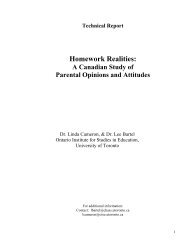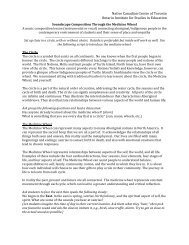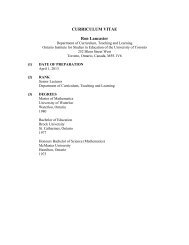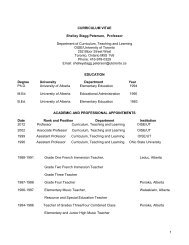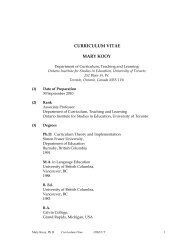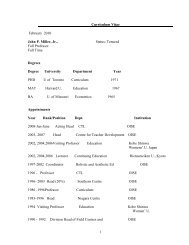The Ontario Curriculum, Grades 9-12 - Ministère de l'éducation ...
The Ontario Curriculum, Grades 9-12 - Ministère de l'éducation ...
The Ontario Curriculum, Grades 9-12 - Ministère de l'éducation ...
You also want an ePaper? Increase the reach of your titles
YUMPU automatically turns print PDFs into web optimized ePapers that Google loves.
environmental technician, project manager), and <strong>de</strong>scribe the education and training<br />
required for these careers<br />
Construction Technology, Gra<strong>de</strong> 11, Workplace Preparation<br />
(TCJ3E)<br />
D. Technology, the Environment, and Society<br />
D1. Technology and the Environment<br />
D1. <strong>de</strong>monstrate an un<strong>de</strong>rstanding of the environmental effects of construction projects, and<br />
ways of reducing harmful effects<br />
D1.1 compare the efficiency and environmental effects of a variety of energy sources used in<br />
resi<strong>de</strong>ntial dwellings (e.g., solar, ground source, pellets, propane, wood, oil, natural<br />
gas, wind)<br />
D1.2 plan projects and processes to minimize waste (e.g., use efficient cutting patterns, reuse<br />
and recycle leftover materials)<br />
D1.3 i<strong>de</strong>ntify ways of reducing energy consumption in the home (e.g., heat recovery ventilator,<br />
tankless water heater, timers, energy-efficient lighting)<br />
D1.4 i<strong>de</strong>ntify programs provi<strong>de</strong>d by community partners and government agencies to<br />
reduce construction waste and to reuse or recycle construction materials (e.g.,<br />
drywall, wood, refrigerants)<br />
D1.5 research and i<strong>de</strong>ntify sources and certifications for construction materials that have been<br />
manufactured using sustainable practices<br />
D2. Technology and Society<br />
D2.3 i<strong>de</strong>ntify the economic and social effects of the construction industry on a community or<br />
region (e.g., direct and indirect effects on employment, waste disposal, land use, water<br />
supply, Aboriginal land claims and traditional hunting)<br />
Custom Woodworking, Gra<strong>de</strong> 11, Workplace Preparation<br />
(TWJ3E)<br />
D. Technology, the Environment, and Society<br />
D1. Technology and the Environment<br />
D1. <strong>de</strong>monstrate an un<strong>de</strong>rstanding of the environmental effects of the woodworking industry,<br />
and ways of reducing harmful effects<br />
D1.1 <strong>de</strong>scribe the major effects of the woodworking industry on the environment (e.g., costs and<br />
benefits related to forest management; non-sustainable logging that causes <strong>de</strong>forestation,<br />
<strong>de</strong>struction of old-growth forests, and/or loss of wil<strong>de</strong>rness habitat for endangered species;<br />
water and air pollutants released during the production of manufactured materials; energy<br />
required to produce and transport materials for woodworking)<br />
Technological Education 181




